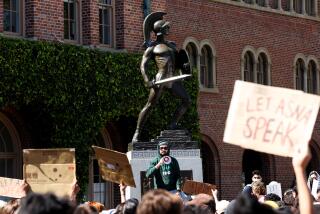Op-Ed: The kids are citizens. The parents are undocumented. What now?
Lupita has been having nightmares. She dreams she is being chased. The fear persists during the day, particularly when she watches news about President Trump’s promised crackdown on immigrants in the country illegally, such as her and her husband.
“Every time I see something, I panic,” said the 40-year-old Los Angeles domestic worker, who asked me not to print her last name. “Whenever I see the news, my heart is horrible. I’m afraid I’m going to have a heart attack.” Her husband Pepe, a construction worker, is more stoic. He doesn’t show his emotions, particularly when their two daughters are around. “But,” said Lupita, “he’s terrified too.”
About 11 million people live in this netherworld of fear. Notwithstanding the bombast of Trump who, astonishingly, told Congress that we have left our “borders wide open, for anyone to cross,” the actual number of immigrants in the country illegally has held steady since 2009, according to the Pew Research Center. What has increased since Trump took office is an atmosphere of dread. Rumors of immigration checkpoints spread on social media. The Los Angeles mayor’s office is distributing cards in English and Spanish advising people not to open their doors to Immigration and Customs Enforcement agents.
Lupita and Pepe’s daughters are frightened. The children were born in the U.S., and so, unlike their parents, who overstayed their visitor visas, have all the rights of American citizens and are not subject to deportation. The 10-year-old is less aware of the threat than her 14-year-old sister. The teenager is given to crying bouts. “She doesn’t want to talk about it,” explained Lupita. “I’ve told her that we have to be prepared. We’ve given her the option to stay or not, but she doesn’t know what to do.”
Undocumented immigrants do not live separate and walled-off lives from the documented, but instead live side by side in the same communities.
— Joanna Dreby, sociologist
At least 9 million people are part of similar “mixed status” families, households in which one member or more is here legally and the others are not. With Executive Order No. 13768, the Trump administration has put them on notice. The federal government is poised to displace and disrupt American families and communities on an unprecedented scale. Trump says “bad hombres” are at the top of the deportation list, but his press secretary, Sean Spicer, makes no apology for casting a wide net. “Remember,” he warned at a Feb. 21 briefing, “everybody who is here illegally is subject to removal at any time.”
It was a stark reminder to millions of people who have built lives here, raising kids, holding jobs, studying, shopping, going to amusement parks — Lupita and Pepe’s favorite family activity. Like Lupita and Pepe, most immigrants in the country illegally have lived here for a decade or more. They’ve planted deep roots.
Lupita came from Mazatlán in 1995, when Mexico was experiencing an economic crisis. Companies were going bankrupt, workers were being laid off, and Lupita couldn’t find a job. So she came to Los Angeles to work and send money back home to her mother. She went to school to learn English, which is where she met Pepe, who had moved from the Mexican state of Michoacán two years earlier. Over the years, Pepe has held a series of jobs, including gutter installation and restaurant, bakery and office work. Lupita was employed at an insurance company but had to quit because of her immigration status, and went to work instead in her family’s L.A. janitorial business. These days, Lupita is a soccer mom who, when she can, chaperones on her daughters’ school field trips. Pepe helps out at their soccer league games.
Both are assimilated into American culture. If ICE forces them to return to a country they haven’t seen in 20 years, would they allow their family to be ripped apart and leave their daughters with relatives? If Trump follows through with promises to deploy deportation forces, he would leave widespread collateral damage with profound social, psychological and economic implications for millions of people forced to make agonizing choices.
Too often, the public, policymakers, the media and even advocates tend to think of a monolithic “undocumented community” comprising members whose lives are separated from the rest of the population. But the reality is far different.
“Undocumented immigrants do not live separate and walled-off lives from the documented, but instead live side by side in the same communities and in the same families,” wrote sociologist Joanna Dreby. For example, Lupita has two cousins, an aunt and three uncles who are all U.S. citizens. Pepe’s undocumented cousin is married to a U.S. citizen. Outside of their family relationships, immigrants in the country illegally are vitally entwined in American society. They are part of our workforce, our communities, our economy, culture, educational system, religious life, you name it. By sheer force of numbers, they are not the “other” — they are part of us, spread throughout our society.
Many states have integrated the undocumented into the official social fabric. In California, nearly 1 million immigrants in the country illegally have driver’s licenses. They can receive in-state college tuition, open bank accounts, sign leases, access hospitals and libraries, practice law and obtain professional licenses from state boards.
Lupita and Pepe try to keep their stress in check, wary about passing their fears on to their children. A 2013 paper for the Inter-American Human Rights Court reported that the children of immigrants in the country illegally are likely to have problems “including emotional wellbeing, academic performance, and health status,” and that “they are more likely to report anxiety, fear, sadness, posttraumatic stress symptoms, anger, and withdrawal.” Deportations multiply the difficulties. If deported parents make the Solomonic choice to leave their children behind, the kids are likely to face “internalizing symptoms (depression, anxiety), externalizing behaviors (withdrawal, aggression), and social and cognitive difficulties.” If the children leave the U.S. with their parents, they “often feel like exiles, and experience difficulties with language and discrimination.”
Families are preparing for the worst. Lupita fought back tears as she filled out a power-of-attorney form, granting custody of their daughters to Pepe’s parents, both legal residents, should the need arise. She held back tears as she checked the various boxes that would allow her daughters to stay in the place where they were born and raised.
“This is their country,” she said. “This is all they know. It will be devastating for them to go to a place they don’t know.”
Jeffrey Kaye is a veteran journalist and author of “Moving Millions: How Coyote Capitalism Fuels Global Immigration.”
Follow the Opinion section on Twitter @latimesopinion or Facebook
More to Read
A cure for the common opinion
Get thought-provoking perspectives with our weekly newsletter.
You may occasionally receive promotional content from the Los Angeles Times.






